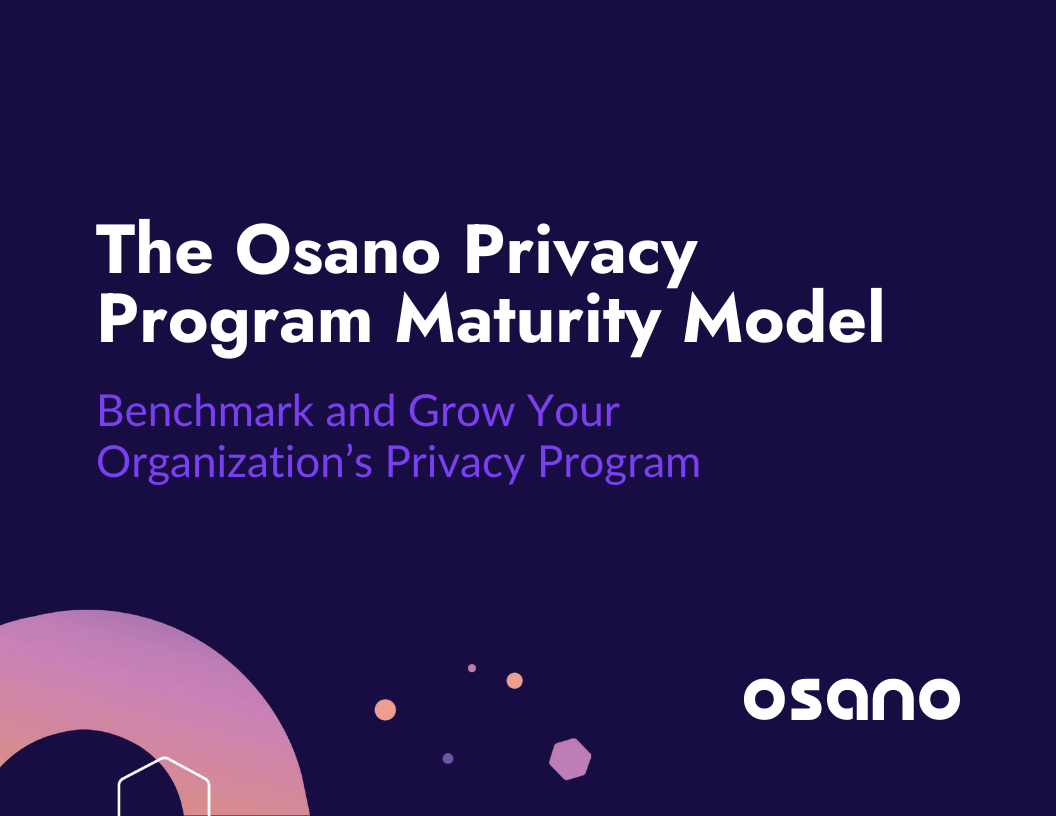Between the dozens of data privacy laws on the books and growing consumer awareness, businesses can no longer afford to collect consumer data indiscriminately. Not only can non-compliance net your organization a seven- or eight-figure fine, poor data privacy practices make you a target for cybercriminals and threaten to damage your hard-won reputation with customers.
So, data privacy is important—how do you actually do it? Data privacy management is the set of practices that enable organizations to actually comply with privacy laws and operationalize their requirements. In this blog, we’ll look at what data privacy management is, why it’s important, how it overlaps with data security, and more.
What is data privacy management?
Data privacy management involves:
- Asking for consent to collect consumers’ personal data.
- Securing consumers’ personal data.
- Responding to security breaches.
- Keeping track of where consumers’ data is stored.
- Understanding where it’s being transferred to.
- Whether it’s being treated compliantly.
- And more.
Data privacy laws impose a slew of requirements, and staying compliant with those individual requirements involves a complex series of tasks and processes.
If a consumer makes a data subject access request (DSAR), for instance, you need to be able to identify where that consumer’s data is stored, review the data to ensure no other consumers’ information will be exposed, share that data with the consumer, and make a record of the request. In order to do this efficiently and within the 30- or 45-day timeline required by law, you’ll need the right system and processes in place beforehand.
Other requirements, like data breach reporting, taking adequate security measures, gathering and acting on data collection consent, and more, have their own complex needs. Altogether, planning, implementing, and acting upon the procedures to meet these needs constitutes data privacy management.
Why is it important?
The EU GDPR was a catalyst for vast changes in data privacy laws worldwide. It raised awareness of the importance of data privacy and security. More specifically, the law made it so that compliance is easiest when privacy and security are involved at the start of any new project or venture, rather than as afterthoughts.
Since then, many similar laws have been enforced. Examples include California’s CPRA, Nevada’s Privacy Law, and many more laws that are already in place or are on their way.
Data privacy management is a crucial step toward compliance. Without this crucial skill, complying with these laws is prohibitively time-consuming at best and impossible at worst. It helps ensure you adhere to all privacy laws that apply to you and it gives you the right tools to respond immediately in case of a data breach.
Data privacy vs. data security
While the two overlap, data privacy and data security aren’t synonymous. Respecting data privacy means giving control back to individuals when it comes to their personal data. It enables them to decide how and when their data can be used and shared. Your responsibilities when it comes to protecting individuals’ data privacy greatly depends on the specific law you need to comply with. A given law might provide certain rights to consumers but not others, might impose certain deadlines, stipulate specific protections or leave it up to your discretion, and so on.
Data security means protecting the personal data of individuals against theft, unauthorized access, or corruption. In contrast to data privacy, your organization will have a broader mandate about how it secures consumer data unless you’re subject to a more specific regulation.
Data privacy and security go hand in hand. Generally, data privacy laws require that you adhere to a minimum level of security, although these laws usually leave the specifics of that security up to you. Additionally, when you’re adhering to data privacy regulations, you also minimize the personal data that could be exposed in a data breach. You may have heard about high-profile companies being fined in the aftermath of a data breach; that’s because the breach may have exposed both a lack of security, which is noncompliant, as well as the noncompliant retention of personal data.
Data privacy management supports data security in this regard. If you’ve got a disciplined, comprehensive data privacy management process in place, then you’ll automatically be more secure. You’ll know where high-risk data lives, enabling you to target it for greater security and watchfulness. Additionally, you’ll know when that data is no longer useful and only serves as a source of risk for you and an attractive target for attackers.
Top 3 benefits of focusing on data privacy management
Data privacy management is critical for your organization. It will help you comply with regulations and avoid fines, but it can also help you bring in more customers and partners. Here are the top 3 benefits.
1. Built trust
Many see data privacy regulations as a nuisance. While they’re sometimes difficult to comply with, they are an opportunity to gain customers’ trust.
More and more people want to know that their data is safe. They don’t want to work with a company that gathers data for the sake of gathering it. Instead, they prefer companies that are transparent about their data collection processes and that value data security and individual rights. In fact, according to Salesforce research, 83% of consumers worry about sharing their personal data online. Moreover, 72% would stop buying from a company over privacy concerns.
2. Improved data governance
Having data scattered everywhere is both unsafe and decreases productivity. Imagine wanting to use part of your data but having to first spend hours finding it. That doesn’t sound like a very effective business process, does it?
Plus, if you can’t find it, you might risk a hefty fine. For instance, under the GDPR, individuals have the right to access, modify, and even delete their data. How can you ensure those rights if you’re not sure where that data is?
By focusing on data privacy management, you won’t have to go through a similar scenario. You’ll have your data clearly stored, categorized, and easy to find.
3. Saving costs
Preventing is better than treating. That’s true for your health, but it is also true for privacy and security.
A violation under the GDPR can cost companies up to €20 million or 4% of the annual revenue, whichever is higher. The greatest fines are for those who don’t respect users’ rights and don’t take adequate measures to protect personal data. Plus, a data breach comes with a damaged reputation and a loss of the customers’ trust.
In short, it is much easier and cheaper to create a system that ensures privacy and security than to repair systems after a breach and/or pay fines for noncompliance.
Top 3 challenges in data privacy management
Focusing on data privacy risk management isn’t always a smooth process. Here are some of the top roadblocks you may face.
1. Difficulty embedding data privacy management mechanisms
Many organizations still treat privacy as an afterthought. That’s the safest way to non-compliance, data breaches, and huge fines.
You need to put data privacy (and security) among your top priorities. Make it part of your business strategy, and include it in onboarding and regular training to make sure your employees are aware of best practices.
While there are many ways to approach compliance and data privacy management, it may be helpful to review what Osano does to stay compliant. The exact nature of data privacy programs differs from organization to organization, but the fundamentals are often the same.
2. Complex regulations and not enough resources
Data privacy laws are very complex and they’re subject to change. You need increased awareness of all the regulations that apply to your business and know all their ins and outs.
Finding the right tools and people who can help you stay on top of all the data privacy requirements is the crucial step. Unfortunately, that often requires a lot of resources which many SMBs lack.
Taking a smart approach to data privacy and security and placing it at the core of the organization from the get-go will help you navigate the process, even with limited resources. Osano customers get access to our Regulatory Guidance solution, which keeps them up to date on the latest legal developments. We also cover a lot of data privacy news in our newsletter, which is available to anyone who would like to subscribe.
3. Increasing amounts of data
Before data privacy regulations, tech businesses abided by the mantra, “Data is the new oil.” Respecting consumer privacy came in a distant second to getting as much data as possible and retaining it for as long as possible. Companies like Facebook, Netflix, and others reached billion-dollar valuations because of the massive amounts of data they collected.
Despite the rise of data privacy regulations, many businesses still retain the perspective that when it comes to data, more is better. Much of the technology that underpins the web and the services that businesses rely on for their daily operations are designed to harness as much data as possible.
The result? Many organizations are now drowning in data, and that poses a serious threat to privacy and security. Unless that data is anonymized, chances are you need to know exactly who it belongs to, why you collected it, how you’re processing it, and for how long in order to be compliant. The more data you have, the harder this is to accomplish, even when applying data privacy management best practices.
Even if your organization is overwhelmed by data, the first step to compliance is to conduct a data inventory, or a record of processing activities (RoPA). If you have a truly unmanageable amount of customer data, your RoPA might not get into the granular details of your processing activities, but you have to start somewhere.
Data privacy management solutions
Data privacy management solutions make addressing these challenges possible. Many data privacy management tasks are ripe for automation, which gives you the time to focus on edge cases, strategy, and other priorities. Features you’ll want to look for include but are not limited to:
- Consent management;
- Risk assessment;
- Privacy impact assessment;
- Tracking data subject access requests (DSAR);
- Data discovery and data mapping;
- Privacy policy and cookie policy generation and maintenance;
- Security protocols such as encryption and user authentication;
- The option to edit the customer’s data.
Managing privacy is a complex process and isn’t something that can be carried out by one person. The legal team, the tech team, human resources, development—virtually every team at any given company touches data privacy at some point.
Minimizing your risk requires proactive education and collaboration around different teams’ data privacy responsibilities. If you have to manage data privacy in a manual way, you won’t be able to engage in this essential education and collaboration work. The right data privacy risk management software takes some of that load off of your shoulders.
With so many options at your disposal, choosing the right solution for your business can be a daunting task. Osano comes to your aid with various solutions, including a consent management platform, vendor risk monitoring, data discovery, and more.
Grade Your Company's Privacy Program
Score and evaluate your privacy program's operational efficiency with the Osano Privacy Program Maturity Model. With this model, you'll pinpoint gaps, identify next steps, and ultimately grow your privacy program's maturity.
Download Your Copy
Osano Staff
Osano Staff
Osano Staff is pseudonym used by team members when authorship may not be relevant. Osanians are a diverse team of free thinkers who enjoy working as part of a distributed team with the common goal of working to make a more transparent internet.
.webp?width=1220&height=1090&name=Osano-guarantee-seal%20(1).webp)




